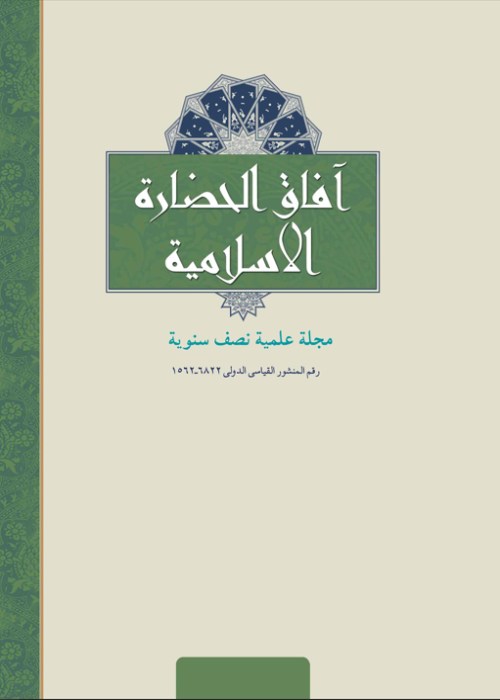The stylistics of syntactic structures in resistance poetry (A case study of Muin Bseiso, Mohammad al-fitoori, and Adnan al-Saegh)
Stylistics is a form of analysis which is primarily concerned with the field of literature. It approaches a literary text from different aspects, one of which is syntactic analysis. The study of the syntactic structures can shed light on the links between the thoughts. Each person, depending on their mental characteristics and the subject at hand, makes use of a number of different syntactic features. The present feature seeks to shed light on syntactic forms resilience poetry, drawing on the works of three poets: Muin Bseiso, Mohammad al-fitoori, and Adnan al-Saegh. Since this form of poetry mirrors the thoughts and beliefs of the people living in one particular society, it is inevitably realistic, alive, and dynamic. Given the biological and cultural diversity of Arabic-speaking communities, this form of poetry can take many different linguistic and stylistic forms. This very issue calls for further studies and research on the style and language of the poets of resilience poetry. On the one hand, each poet has made use of a different style depending on the extent to which he has been affected by the status quo and socio-political changes of his country and each poet enjoys a style which differentiates him from other poets. Therefore, cultural, social, and political environment of these poets, their position and prominent role in the contemporary Arabic poetry, all of which bear solid themes, have led to their selection. Given the wide variety of syntactic structures, only nominal and verbal structures, tense, and Modality are of concern to the present research. The aim of the present research is to shed light on the aspects to which poets have resorted to achieve the common goal known as reliance poetry. Therefore, the main research problem is to identify and stylistic study of the syntactic structures of these three poets. In this way, the idiosyncratic style is identified along with the type of their interaction with language.The present study follows a descriptive -analytical-statistical approach. Twenty odes from each poet on the theme of homeland were selected. These odes were selected to shed light on how linguistic and stylistic components were made use of to express their thoughts and beliefs and best depict this form of literature.With regards to the results, it was found that Bseiso’s style is characterized by nominal structures with verbal predicates. The political position of this poet as the head of the Palestinian communist party leader. On the other hand, his physical presence in the fights against the Zionist enemies could be considered as factors that could lead to his usage of singular pronouns in nominal structures. al-fitoori has mostly utilized nominal structures and singular pronouns to express his thoughts and feelings in his initial poetical works. This is due to the grim social and political situation of his time when colonialists were looking to destroy their culture and identity. He also consolidates his being and presenxe by using such structures. However, verbal sentences in al-Saegh’s poetry are more frequent compared to Bseiso and al-fitoori's and can be considered as one of his stylistic features. This can be due to the narrative and storytelling aspect of his work. The expression of such concepts inevitably entails the usage of verbal structures.In al-Saegh’s works, tenses are either past or present. He does not seek to escape from the reality by depicting the old world; rather, he levels criticism at the current situation of the society that cannot create a link between its two different worlds. To disentangle from this bipolarity, he creates another world in the past tense. Such a style is an indirect mode of expression to express objections. However, Bseiso and al-fitoori’s works are almost completely set in the present tense.Declarative forms are stylistic features of al-Saegh’s poetry. He makes flashbacks to the past and depicts the scenes in a natural way. Nonetheless, unlike al-Saegh’s poetical works, most of al-fitoori’s odes are a combination of different kinds of verbal modalities in the macro-structure of odes. However, in Bseiso’s works, due to his wrathful spirit, the decisiveness and function of the declarative structure is highly common. He has explicitly expressed bus thoughts using this structure and humiliates and ridicules his enemies by drawing on imperative and interrogative structures. However, imperative structures are less frequent in al-Saegh’s works. Due to his bitterness towards war, he does not try to persuade the soldiers to fight. His obligatory participation in war has played a role in this matter and has led to him using declarative and narrative forms to retell and depicts the status quo of the country. The essay aspect of his sentences, which is mostly reflected in his interrogative modes, is in fact coveted in despair and disappointment.
- حق عضویت دریافتی صرف حمایت از نشریات عضو و نگهداری، تکمیل و توسعه مگیران میشود.
- پرداخت حق اشتراک و دانلود مقالات اجازه بازنشر آن در سایر رسانههای چاپی و دیجیتال را به کاربر نمیدهد.



